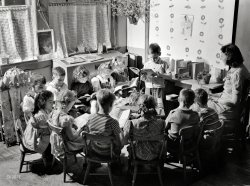
MAY CONTAIN NUTS

Search Shorpy
SHORPY ART

Framed or unframed, desk size to sofa size, printed by us in Arizona and Alabama since 2007. Explore now.
Join and Share
Ad-Free Shorpy
Shorpy is funded by you. Patreon contributors get an ad-free experience.
Learn more.

Recent comments
- If You’re Like Me, Never
- U.S.A.
- S&P
- 1940 Zenith radio model 6G601
- Quality goes in before the name goes on!
- Snazzy skirt
- Carbon Arc Lamps
- Illuminate us
- I remember it well
- I can't prove it
- Complicated then, forgotten now
- Bryan-Stevenson
- Skinny is as skinny does
- How do you rest in peace
- Riding the footboards
- Alas, hidden from view
- Baldwin Diesels
- Exclusive pump
- Bananas, Oysters and Smokey Joe
- Details, Details
- What's that building to the left of the tower?
- Coal Barges
- Bromo-Seltzer
- Inner harbor
- The Basin
- What a headache!
- Giant stepladder?
- Yeah, it was cold
- Love those coats
- Link & Pin Days Remnant
Member Photos
The Shorpy
Print Emporium
Print Emporium
Search Shorpy
Search results -- 30 results per page
- The Metropole: 1915
- ... plug fuses feeding four 15 amp branches! We still have two interior walls we never opened, with k&t intact, tied into Romex in the ... Posted by Dave - 07/08/2018 - 8:20pm -
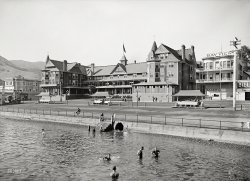
- Loves Olives: 1956
- ... everywhere at the time: car paint, fiberglass boats, interior décor, furniture, home exteriors, advertising layouts, product ... Posted by Dave - 06/14/2012 - 4:59pm -
![Loves Olives: 1956 Southern California circa 1956. One of a dozen Kodachrome slides that I recently found on eBay. If the clothes here were any sharper we'd need to call 911. No T- shirts and jeans for these folks. More to come over the weekend. View full size.
Pink Golden AgeIf this photo was shot in 2012, the young woman's clothing would be far different. The Pink Top would be gone and the Dress would be daringly unbuttoned.
It's been interesting watching Shorpy Photos and seeing the progression of women wearing less and less clothing through the years since the camera was invented. Seems the 1950s was the happy medium.
What were we thinking?I’m guessing the guy on the left is wearing suede shoes. 1955/56 were the years of pink and charcoal attire for men of the world, as were blue suede wingtip shoes. What we can see of him measures up to the standard, so I’m assuming his footwear does also---including the obligatory pink argyle socks. Pastel colors abounded everywhere at the time: car paint, fiberglass boats, interior décor, furniture, home exteriors, advertising layouts, product packages, etc. Thankfully, providence spared us the simultaneous affliction of women’s sack dresses during the same period, as they were still a couple of years off.
"Mad Men," eat your hearts out!Why does the song "Sharp Dressed Man" come to mind? Seriously, the clothes are wonderful!
Green olive loverThat's a really cute girl! I'm wondering what the story is about the b&w photo of the white couple. Maybe Olive Girl is biracial and those are her grandparents. I'm speaking this as a mother with two biracial kids and three biracial grandkids, as of yesterday (baby boy, 7lbs 6oz)!
UnforgettableHaving been a fan of Nat King Cole, I attended some of his concerts in the early '60s. He dressed so very similar to these two men, very elegant, slender, meticulously groomed and a very smoooooth operator. As soon as I saw this picture, I was reminded of his demeanor. He was especially graceful and attentive to his fans and yet was so humble and congenial to all and his voice was one in a trillion, never to be duplicated. Even though these two do not really look alike, they both interpreted his sophisticated "style" beautifully.
What my sons would say"If you could get ALL those olives in the dish into your mouth at the same time, I'll give you a quarter." This was the kind of stunts they'd pull in their teen years and beyond. Their youngest brother at age 5 had a near tragedy trying to fit a whole wedge of cantaloupe in his mouth at once. Thank goodness Mom intervened.
Great Photo findThere are still many of us around from that age and that time. Dave, I hope you can get some names to attach to the pictures. I'm looking forward to the next of the set.
[Alas, the only name on these slides is "Kodachrome." -Dave]
B&W PhotoI don't think the couple in the photo are white noelani. I think the woman is just lighter skinned.
(SoCal 1956 Kodachromes)](https://www.shorpy.com/files/images/SHORPY_Olive_Party.thumbnail.jpg)
- Make Yourself Comfortable
- ... uncomfortable feel to it IMO - two thumbs down for the interior designer.
Early Guest Upon spotting the odd collection of ... Posted by Dave - 09/11/2011 - 4:10pm -
![Make Yourself Comfortable Washington, D.C., 1920. "National Photo Company, front room." View full size. Glass negative: National Photo Company Collection. Styling: Morticia Addams.
BackdropIs that a camera on the far right? I bet a lot of portraits were taken in front of that wall of sharp implements.
Now that is some seriouslyNow that is some seriously weird-looking furniture. The whole room has a very uncomfortable feel to it IMO - two thumbs down for the interior designer.
Early GuestUpon spotting the odd collection of weapons hanging on the wall the early guest began to wonder who has invited him to dinner. Or if it was him who is the dinner...
My voteIs two thumbs up!!! I just love the oddity of it all and I cannot believe it is the waiting room of a business office!! I don't think I would leave for hours - just looking at all of the photos and weaponry and antlers, OH MY!
My thought...is that the photographer put all the photographic staging pieces in the front room. I also think it's a good idea to display some curiosities for people to look at whilst waiting. I wish more businesses would do that today.
Love The Title!I laughed out loud at the title of this photo! Comfy, indeed! In that room, I imagine that the furniture is made out of human bones! Although bamboo might be closer to the truth. Does anyone want to guess what the subject matter is in the photo next to the antlers? It appears to possibly be a close-up of some sort of animal dung? But, I'm sure I am wrong about that, too. I hope...
Kathleen
Charming photoMy guess about the photo next to the antlers is that it's a coiled snake.
I get a whole King Kong/Skull Island vibe from the furniture motif; I wonder if Merian C. Cooper had visited the National Photo Company 13 years before? I would definitely make room in my place for that vanity/lamp combo, although I'd be real careful getting up from it.
Mighty Hunter?This is an odd juxtaposition of styles. That desk looks painful. It actually looks more like a vanity table. Maybe this is a young couple with the usual starting out mixture of his manly trophies and her teenage girl bedroom furniture.
[This is the reception area of a business office. And that may well be Herbert E. French himself on the couch. - Dave]
(The Gallery, D.C., Natl Photo)](https://www.shorpy.com/files/images/29861u.thumbnail.jpg)
- Slush Hour: 1916
- ... feet.
The plans call for two electric elevators and an interior arrangement of offices, single and in suites, of from two to six ... Posted by Dave - 09/12/2011 - 12:00pm -
![Slush Hour: 1916 Washington, D.C., in a circa 1916 time exposure. "Corner of 7th and F northwest." National Photo Company Collection glass negative, 8x10 inches. View full size.
Police SwordsI find it fascinating that the policeman is carrying what appears to be a sword.
[That's a nightstick. - Dave]
Unassailable SupremacyHorn the Tailor was a bit like the Crazy Eddie of his time: insane deals, high volume, lots of advertisement.
F and Seventh TodayWent from a White Barber to the Verizon Center..
View Larger Map
Still ThereIt appears the Barrister Building is still standing, albeit with a set of large bay windows installed on the lower floors. The buildings on the far right also appear largely intact.
[This is looking down Seventh, not F. Welcome to Shorpy! - Dave]
View Larger Map
High Style on a Narrow LotThe Barrister Building is packing a lot of Renaissance style grandeur as well as height onto a single narrow lot. If I'm scaling this correctly as I look at it, it appears that the lot is an urban standard width of 25 front feet. Is that the case in Washington? Two of the upper floors also appear to be vacant, with For Rent or For Lease signs, causing me to wonder if this is a construction completion record photo. Is the date of this building known?
[It was built around 1910. - Dave]
Barrister BuildingI love the juxtaposition of architectural styles here: Colonial, Second Empire, Victorian and Romanesque. Dave seems to be having quite a fixation with Mansard rooflines this week.
Office Structure Begun
Foundations are Laid for the Barrister Building
Foundations for another nine-story office building for Washington are being laid at 635 F street northwest, and within the next week or two the public will be able to obtain a general idea as to how large the structure will be when it is completed. the building will be called the Barrister building, and will be a modern, fireproof structure, with a 29 foot frontage and depth of 120 feet.
The plans call for two electric elevators and an interior arrangement of offices, single and in suites, of from two to six rooms. The furnishings will be in cherry and mahogany, with all the other appointments in keeping, and such as will constitute this an up-to-date structure in every respect.
the front of this first story will be of marble. a light brick, with terra cotta trimmings, will be used above the marble.
Appleton P. Clark, jr., the architect, has incorporated in them all the features which the modern office building must contain. The structure will be erected by Charles J. Cassidy Company, and A.C. Houghton, of 623 F street northwest, will the the rental agency. The Barrister building will be ready for occupancy in July.
Washington Post, Feb 13, 1910
Barrister Building photographed in October 1970 as part of HABS project (Historical American Building Survey)
Oops!That should serve as a helpful reminder to double check street names.
And thank you for the welcome despite my mistake. I've posted here before but for some reason I never created an account.
Dirty SnowI'm deriving a certain amount of comfort in the realization that the dirty, slushy snow pushed to the curb is the same throughout the centuries. It's nice to know that some things never change. I'm also appreciating that handsome shoeshine stand at the corner, too. It was thoughtful of its attendant to stand aside when the photo was taken so that we'd get a clearer look at it. Those cornucopias hanging from the top of the Barrister Building are a nice touch as well.
The fleetingness of lifeEvery time I look at this picture I never fail to be reminded of that famous passage in The Tempest:--
Our revels now are ended. These our actors,
As I foretold you, were all spirits and
Are melted into air, into thin air:
And, like the baseless fabric of this vision,
The cloud-capp'd towers, the gorgeous palaces,
The solemn temples, the great globe itself,
Yea, all which it inherit, shall dissolve
And, like this insubstantial pageant faded,
Leave not a rack behind. We are such stuff
As dreams are made on, and our little life
Is rounded with a sleep.
(The Gallery, D.C., Natl Photo)](https://www.shorpy.com/files/images/30761u.thumbnail.jpg)
- Asleep at the Wheel: 1942
- ... new Roadmaster (whose rearmost porthole accessed the car's interior) into which several of his young scholars saw fit to urinate through ... Posted by Dave - 11/20/2019 - 7:13pm -
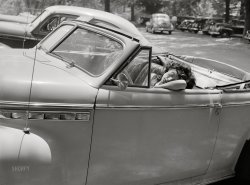
- Emergency Hospital: 1920
- Washington, D.C., circa 1920. "Emergency Hospital, interior." The latest in lab facilities. Harris & Ewing Collection glass ... Posted by Dave - 08/27/2012 - 5:05pm -
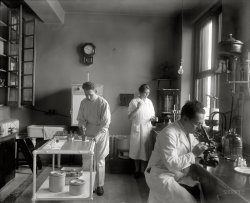
- Strangers on a Train: 1928
- "Southern Railway, interior of car," circa 1928 in or near Washington, D.C. National Photo Company ... Posted by Dave - 09/04/2012 - 12:03pm -
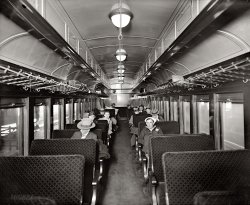
- The Palace: 1920
- ... to enjoy this grande dame hotel on a recent visit, and the interior spaces are as beautiful the streetscape. The Garden Court is an ... Posted by Dave - 05/03/2016 - 1:05pm -
![The Palace: 1920 "Market Street, San Francisco, 1920." Starring the Palace Hotel and, rising behind, the Call Building. 8x10 glass negative. photographer unknown. View full size.
What is writtenon the sidewalk at the bottom right.
[CROCKER SAFE DEPOSIT VAULTS. Camouflaged as manholes. - Dave]
What's up?Those are the tallest street lights/lamps I have ever seen. Can't imagine the purpose of putting them that high up, and maintenance must have been fun.
[They're still in use on Market Street, including at this very corner. -tterrace]
Street Lights.The reason the street lights are so high is they served dual purpose. If you look closely you can see where the catenary (trolley wire) is actually attached to them. This actually wasn't all that uncommon at one time, since it allowed the city to have its public transit system, and to hide the (usually) unsightly support poles. What's more, it also meant that you didn't have to clutter things up with a second set of poles for the lights themselves.
Gorgeous Inside and Out!My husband and I were able to enjoy this grande dame hotel on a recent visit, and the interior spaces are as beautiful the streetscape. The Garden Court is an amazing space, I only wish we'd been there during the day to see the stained glass skylights.
"The Roar of the Four"The title is in reference to the constant stream of streetcars during the era of competition between the Municipal Railway and the Market Street Railway. Today the Muni has two surface tracks as well as two subterranean tracks at this location. Below them BART has its too tracks. Roar of the Six?
Let There Be LightsThose extra-tall streetlights are actually historic landmarks, specifically "San Francisco Landmark #200 Path of Gold Light Standards." They're part of the City Beautiful movement of the early 1900s, meant to illuminate San Francisco's then-primary artery Market Street.
Initially installed in 1916, the poles' bases were designed by famed West Coast architect WIllis Polk and feature bas relief images of covered wagons, mountain lions, and alternating prospectors and Native Americans.
For more info on Path of Gold check out this page.
(The Gallery, Cars, Trucks, Buses, San Francisco, Streetcars)](https://www.shorpy.com/files/images/SHORPY-963.thumbnail.jpg)
- Cascade: 1941
- ... 1935, and ultimately an appeal by the US Department of the Interior to the Supreme Court, which Arizona won. The ensuing settlement ... Posted by Dave - 06/08/2011 - 2:14pm -
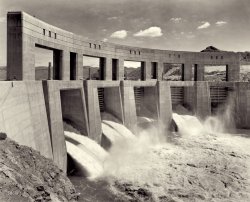
- Kodak Moment: 1926
- ... with the Eastman House? I found some pix of the interior, but none of the room I have in mind.
[This was taken at the ... Posted by Dave - 09/04/2012 - 12:59pm -
![Kodak Moment: 1926 1926. "Jimmie Jr., Jane, Joan, Jean Davis (Lee Hart job)." Dad James Davis was Secretary of Labor in the Harding, Coolidge and Hoover administrations before being elected to the Senate. National Photo glass negative. View full size.
Great pictureImagine if the picture that Jimmie Jr. took could be matched up with this one. The expressions on all four children are priceless. The doll less so. BTW this was the year my mom was born .. about same age as Jewell and still going strong!
[Jimmie Jr. is holding a movie camera. - Dave]
What every house with kids needsA sun porch a mile long!
Location = Eastman House?Ya know.... I'm still trying to find a picture, but that "sun porch" actually reminds me a LOT of a long glassed hallway at the George Eastman House in Rochester, New York. It kind of a long glassed sunroom that connects portions of the mansion and looks out onto the gardens.
Maybe it REALLY was a Kodak moment!
Does anyone know where this was really taken or have better familiarity with the Eastman House? I found some pix of the interior, but none of the room I have in mind.
[This was taken at the family's home in Washington. - Dave]
Jimmie, Jane, Joan et alJimmie, Jane, Joan & Jean. I hope the children grew up duly resentful.
[There was also baby sister Jewell, not pictured. - Dave]
The J's have it!My parents did the same thing to us and it continues through the generations: JoAnn, Judi, Jackie -- then Jennifer and Justin -- then Joey, Jonathan, Julian (the newest). And one sister, Carol, born just after Christmas. (Why not Joy??)
What a DollLittle girl on the right is holding a Kathe Kruse doll.
(The Gallery, Kids, Natl Photo)](https://www.shorpy.com/files/images/27566u_0.thumbnail.jpg)
- Retail White House: 1910
- ... looking for elsewhere, but always enjoyed the beautiful interior of Maison Blanch. The upper floors were offices, including dentists. ... Posted by Dave - 07/26/2016 - 3:33pm -
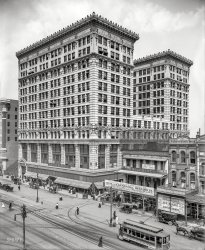
- Crank It: 1939
- ... May Avenue, Oklahoma City. Photographs show exterior and interior of shacks, tents, other makeshift shelter in May Avenue camp which is ... Posted by Dave - 10/22/2019 - 12:05pm -
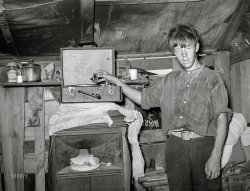
- Rules of the Sale: 1920
- ... Washington, D.C., circa 1920. "Conbro clothing store, interior." Happy shopping, everyone. National Photo Company glass negative. ... Posted by Dave - 05/29/2018 - 9:39pm -
![Rules of the Sale: 1920 Washington, D.C., circa 1920. "Conbro clothing store, interior." Happy shopping, everyone. National Photo Company glass negative. View full size.
And free alterations too!A couple of the salesmen have tape measures around their necks so they can make the clothes fit perfectly. This looks like the wedding gown sale at Filene's except they are all men and it may be a summer clearance since they are wearing straw hats. Imagine, not a single domineering wife or girlfriend is visible in there to tell her guy what to wear.
[It's spring ("spring suits," palm fronds). - Dave]
Re: "free alterations"I take that back. After further scrutiny, I see ONE "battle-axe" facing the camera who IS going to have a voice in her man's attire. She's wearing earrings and a turned-up brim. Sorry.
"Sale" prices?Wow! For a clearance sale, these seem lofty for the time!
Today, that $24.44 suit (or jacket?) would cost $262, using the Consumer Price Index, or $1350 (!!) using GDP Per Capita, an estimate of "affordability."
AlterationsWell of course you could get alterations, but they're not included in the sale price.
A week's pay for a pair of pantsI was surprised by the prices as well. This illustrates how much we would all likely be paying for clothes right now if they were all still made in the USA.
Mystery SolvedCONBRO Clothes, which was located at 930 F Street NW, was next to the Metropolitan Theatre. It appears to have been in business for approximately one year with advertisements for the store starting to surface in local newspapers in December 1919. This store was managed by Jack H. Koppelman. A fire at their warehouse at 116 E Baltimore Street, in Baltimore, Maryland, preceded the sale scene shown in the photo here and in the sale announcement below from the Washington Times on August 4, 1920. No date for the fire was given in the other ad.
Conbro claimed there were a total of 10 stores in the chain, but no details of other locations were provided. Possible locations, culled from multiple sources, seem to have been Pittsburgh, Akron, Indianapolis, Flint, and Detroit.
(The Gallery, D.C., Natl Photo, Stores & Markets)](https://www.shorpy.com/files/images/29306u.thumbnail.jpg)
- Llano de San Juan: 1940
- ... Administration.
Llano de San Juan There is an interior photograph of a house in Llano de San Juan in the Getty Museum in Los ... Posted by Dave - 08/30/2012 - 2:01pm -
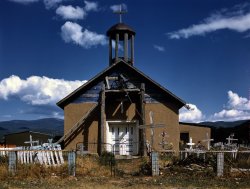
- Photo Op: 1921
- ... take Standing (l to r): Albert Fall, Secretary of the Interior, architect of the Teapot Dome scandal; William Hays, Postmaster ... Posted by Dave - 06/18/2012 - 5:29pm -
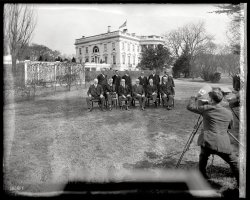
- Indyrama: 1905
- ... that the top floor of that building was wide open with no interior support columns, thus necessitating the roof iron. Can anyone ... Posted by Dave - 08/28/2015 - 12:00pm -
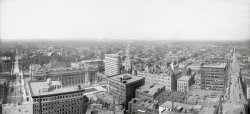
- Re-Tirement Home: 1940
- ... and have a 6" deep layer of sludge in the shape of the interior of the valve covers, with small gaps where the oil was forced out of ... Posted by Dave - 06/19/2018 - 10:17pm -
![Re-Tirement Home: 1940 March 1940. "Secondhand tires displayed for sale at service station in San Marcos, Texas." A leading candidate for the first Krispy Kreme franchise. Medium format negative by Russell Lee for the Farm Security Administration. View full size.
Carbonated CokeIt seems that this 1937 Ford sedan's flathead V8 is getting a de-coke job. The engine compartment's side panel has been removed for access and is resting against the Ford tire rims along the wall, with a new head gasket lying on it. The cylinder head has been removed and the gent who is just visible behind the right side of the car is scraping the carbon that has built up inside the head's combustion chambers (called decoking or decarbonizing). This was a common procedure on older cars, given their low compression and the poor quality of fuels. Buildup of carbon (coke) led to a drop in engine performance, so it had to be cleared out from time to time. Indeed many owner's manuals even had the procedure detailed for the owner to perform himself.
Why I follow ShorpyThe wonderful titles, hilarious takes like the "first Krispy Kreme franchise" in descriptions, and that the very first comment is a detailed explanation of what some guys working on a car 80 years ago were really doing.
Major repairsAt the time it was common practice to do engine overhauls, including the aforementioned carbon removal, cleaning out the oil pan and passage, and replacing the main bearings. In many cases, the main bearings were poured in place - the bearing material (babbit or something like it) would be melted and poured into place in the journals. This was something a good service station would do, maybe in less than as 50,000 miles.
This was before detergent oil, so crud would just fill it up eventually. I have seen cars from as late as the 60s where oily sludge had built up to the point that it filled up the engine, so you could take off a valve cover, and have a 6" deep layer of sludge in the shape of the interior of the valve covers, with small gaps where the oil was forced out of the passages.
Now it is normal and expected that an engine will run 200,000 miles with no internal failures or significant wear, and no real maintenance aside from oil changes. To the point that everything else in the car has been destroyed long before the engine goes bad. The "good old days" sucked, for the most part.
Wheeling in more ways than oneThe building is at least partially clad in Wheeling Corrugating Company's "Cop-R-Loy" steel, as we can see by the imprint above the side garage. This brand of sheet goods consisted of a mild steel with a small amount of copper added to reduce corrosion. It was quite popular and used in a great many water-contact steel products of that era. I still have a bucket in the garage with the same brand ... and still no rust!
It's 1939 and 1940The month is March, and the Model A coupe is wearing a 1940 license plate, while the '37 Ford sports a 1939 plate. Until 1975, vehicles in Texas had to get new plates every year, and drivers had from January through March to register. This usually meant long lines of procrastinators at county tax offices at the end of March each year.
Third row, second from leftand put it on my new-fangled Sinclair credit card.
Just off the squareWithout going to stand on the spot I can't be 100 percent positive, but I believe this station stood on West Fort Street, also known as Texas Highway 80, maybe half a block west of the courthouse. (Fort Street was later renamed Hopkins.) At the far left of the picture, one of the cornices of the Hays County Courthouse (still standing, now with a New Improved Historic Designation) is visible.
Sinclair Credit CardsI didn't know there were credit cards of any kind back in those days.
Sinclair Gas Credit CardThe card was not a credit card but a GAS CARD, that you pre-filled before a trip that you could use to pump gas at their stations. The research on Sinclair's Website only turned up data about the company here.
[Like the sign says, it's a credit card. You charged your gas, then the company mailed you a statement at the end of the month. Pre-filled cards had to wait for the computer era. - Dave]
[Ah! I stand corrected]
(The Gallery, Cars, Trucks, Buses, Gas Stations, Russell Lee)](https://www.shorpy.com/files/images/SHORPY-8b24221a.thumbnail.jpg)
- Dentist Gas: 1921
- ... handsome new fixtures substituted at great expense. The interior finish of the store is in white. Wall showcases have been used ... Posted by Dave - 09/13/2011 - 12:17pm -
![Dentist Gas: 1921 Washington, D.C., circa 1921. "Louis & Co., Seventh and G." A convenient grouping of Victrolas, painless dentistry and patent advice. View full size.
What We Have, You Get
Washington Post, Dec 20, 1914
Gets New Drug Store
Company Begins Business Tomorrow at 7th and G Sts.
The opening of the Washington branch of the Associated branch of the Associated Drug Stores, Seventh and G streets northwest, tomorrow morning, marks the acquisition of one of the finest and most modern establishments of its kind here. The drug company, of which Dr. M.M. Whitehurst is president, has four stores in Baltimore, and has met with success there.
The new establishment will feature its opening tomorrow by giving away souvenirs, including candy, flowers, perfume, and other things with purchases of 50 cents and over. Flowers will be given tomorrow and Tuesday to ladies.
There will be various departments of the new establishment, including the prescription, cigar, soda fountain, candy, as well as general drug department. The prescription department which is especially well fitted, will be in charge of two registered graduate pharmacists, and will be able to fill prescriptions on short notice.
Another feature is the 30-foot soda fountain, said to be the largest in this section of the country. It will be in the charge of competent men, and is strictly hygienic. Sterilized glasses, filtered water, and fresh fruits will be attractions.
The management will make a specialty of guaranteeing everything that is sold in the store, and if anything is not entirely satisfactory it can be returned and either money refunded or another article given in its place. "Best goods at the lowest prices," is the motto of the company.
The new store building, which is centrally located, was formerly occupied by a branch of the United States Trust Company. The inside of the structure was torn out, and handsome new fixtures substituted at great expense. The interior finish of the store is in white. Wall showcases have been used throughout so that the customer may see everything. This is sad to be an innovation for Washington. The proprietors will make a specialty from time to time of great bargains in the drug, candy, and other departments.
What We Have, You Get
Count 'EmI see about 28 Nippers. There are a couple more suspects, but I can't tell without more magnification (or younger eyes).
Street ViewAmazingly similar today...
View Larger Map
Hardest working dentistAmazing, Dr. Truett's hours are 8am-9pm!
WhereIs the Drug Store?
[To the left of Louis & Co. - Dave]
The Moran BuildingThe Moran Building at 501-509 G Street NW in the Chinatown neighborhood of Washington was built in 1889 by J.E. Moran (first three floors; fourth floor and mansard roof added in 1890 by George Bogus) and is an example of Second Empire architecture. In 1983 it was added to the National Register of Historic Places. Current tenants include a Burger King restaurant.
[As noted above, the Moran is not the building in our photo. - Dave]
Misplaced MoranThe Moran Building with the Burger King is actually a block over, on the other side of Verizon Center.
+95Below is the same view from May of 2016.
(The Gallery, D.C., Natl Photo, Stores & Markets)](https://www.shorpy.com/files/images/30015u.thumbnail.jpg)
- Street Pusher: 1943
- ... probably sold for a quarter.
The Godfather Baptism interior scenes were shot in Old St. Patrick's Cathedral.
Ice Man My ... Posted by Dave - 09/14/2013 - 6:24pm -
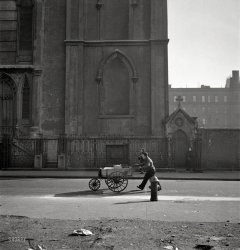
- Patent Office: 1918
- "Interior, Patent Office," circa 1918. Harris & Ewing. View full size. ... Posted by Dave - 07/17/2012 - 10:20pm -
![Patent Office: 1918 "Interior, Patent Office," circa 1918. Harris & Ewing. View full size.
2nd Floor ChaosSpeaking as a former file clerk, that 2nd floor filing system is horrendous! What a mess! The third floor is a breath of fresh air. All nice, neat, and orderly.
Nice TouchSplendid space, wonderful proportions; especially like the "Juliet" balconies at the second floor level around the columns. A nice touch!
What a nightmare!All that paper! I wonder how long it took to catalog that mess.
Desks with a viewLook along the "Juliet" balconies and notice that two lucky folks have desks on balconies. Who needs a window when you look out over that grand arcade (and have your back to the mess on the shelves on the second floor).
A Question for DaveDave, is this building still with us? Or has it been lost to progress also? Thanks!
[The Smithsonian Institution took over the building in the 1960s. It's now home to the National Portrait Gallery and Smithsonian American Art Museum. It reopened in 2006 after a six-year, $250 million renovation.- Dave]
View Larger Map
A recent look ...... down this same hallway:
ArcadeThe inside hallway reminds me of the old turn of the century Arcades that were built in Cinncinati and other parts of the midwest and east. They provide cover and shopping during the harsh winters and hot summers. I think today's suburban mall will never be able to produce something as beautiful and socially gratifying as this and these.
(The Gallery, D.C., Harris + Ewing)](https://www.shorpy.com/files/images/14244a_0.thumbnail.jpg)
- What Goes Up: 1925
- ... is one of only 15 properties in DC with a historic interior designation. In 2000 the building was purchased with funds from ... Posted by Dave - 02/22/2013 - 4:48am -
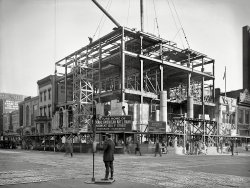
- Frenemies: 1900s
- ...
The bald fellow Ethan Allen Hitchcock. The Sec'y of interior in 1901.
[Interesting guess, but I don't think so. -Dave]
... Posted by Dave - 10/27/2019 - 3:25pm -
![Frenemies: 1900s Washington, D.C., ca. 1900s. "Flatmouth, Chief, group." Chief Flatmouth, the formidable-looking gent seated at right, is wearing a medal that reads REDMEN'S CONVENTION, WALKER MINN., Aug. 12th 1901. The bald fellow and the Chief's lieutenants await identification. Harris & Ewing photo. View full size.
The bald fellowEthan Allen Hitchcock. The Sec'y of interior in 1901.
[Interesting guess, but I don't think so. -Dave]
Peace pipesWonder who made those finely crafted pipes. They look like metal, or possibly recycled gun barrels that were melded together and shaped. Part flintlock, part rifle? And would native Indians have had the means to bore a hole down the length of those long pipe handles? Could these have been provided by our government as gifts?
Made in Minnesotahttp://www.nps.gov/pipe/index.htm
Probably made from the pipestone found at the Pipestone National Monument, Minnesota.
As for boring the hole? I guess it could be done with simple tools.
William Atkinson JonesCommissioner of Indian Affairs.
[Noop. - Dave]
I think it *is* Ethan Allen HitchcockNot the General Ethan Allen Hitchcock who died in 1870, this is his nephew. Fellow in this picture looks like the Wiki of the nephew.
[Two different people. - Dave]
If I may....With the exception of the Bureau of Indian Affairs [BIA], bureaucrat [the bald gentleman], these Ojibwe [Chippewa], men belonged to the Pilager Band of Ojibwe on the Leach Lake Reservation in Minnesota. The headman, seated on the right, is Niigaaniibines, son of Eshkibagikoonzhe who was a prominent Ojibwe in the first half of the 19th century in Minnesota territory. The French fur traders pinned the nickname "gueule platte" meaning "flatmouth" on Eshkibagikoonzhe because they were unable to pronounce his Ojibwe name. There is a sculptured bust likeness of him in Washington DC when sketches of him were done while he was on official business there in 1855. That trip also included other Ojibwe headmen from the midwest resulting in a treaty that ceded some 10 million acres of virgin pine land including the headwaters of the Mississippi River. That did not sit well with many Ojibwe people and the elder Flatmouth soon died after. Niigaaniibines "inherited" his father's nickname and then became known by the same name to early settlers in northern Minnesota. The younger Flatmouth died in July of 1906. Some of his personal Indian regalia is on display at Northwestern U. in Evanston, Ill.
The young man standing in the button coat, 4th from left, was the official interpreter for this group. The tall man wearing the brim hat, 3rd from left, is Dave Boyd. He was 6'6" and lived on Buck Lake on the Leach Lake Reservation. He served as a Leach Lake Reservation police officer. A granddaughter of Dave Boyd worked as my assistant back in the 1970's.
No, the stems on those pipes are not made from rifle barrels nor from stone. They are always made from wood while the pipe heads are most often made of red stone quarried at Pipestone, MN although some pipe heads are made from a certain black stone found in river beds.
(The Gallery, D.C., Harris + Ewing, Native Americans, Portraits)](https://www.shorpy.com/files/images/SHORPY_15436a.thumbnail.jpg)
- Human Hair Goods: 1905
- ... close corner is a neat bank building with a dome and rich interior. Or was.
Returning to former glory That building is being ... Posted by Dave - 05/06/2014 - 10:26am -
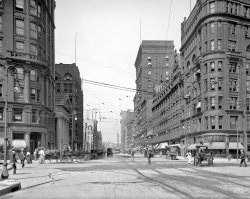
- Shawnee Tavern: 1937
- ... least was when I last saw it about 4 or 5 years ago. The interior, unfortunately is crumbling lath and plaster and murals. You cannot ... Posted by Dave - 10/28/2015 - 11:43am -
![Shawnee Tavern: 1937 April 1937. "The Posey Building of Shawneetown, Illinois, in which Abraham Lincoln and Robert Ingersoll had law offices." Now home to a newspaper and a bar. Photo by Russell Lee for the Resettlement Administration. View full size.
Deposeyed.These steps are all that remain of the Posey Building.
Wrong addressThe Posey building was in Gallatin
597 Main St
Gallatin, IL 62984
[Gallatin is not a town, but rather a county in Illinois; the county seat is Shawneetown. 62984 is the ZIP Code for Shawneetown. -tterrace]
Old ShawneetownAccording to Wikipedia, Shawneetown was heavily damaged by the Ohio River Flood of 1937, and the townsite was moved three miles inland and the town rebuilt. From the age of the buildings here, this must be what is now called Old Shawneetown (refer to the previous picture posted here for another building destroyed by the flood). The county seat is now in what is informally called New Shawneetown.
Gallatin DemocratThe newspaper is still being published:
Fred Murphy is the editor of the Gallatin Democrat.
Mailing address: PO Box 545, Shawneetown, IL 62984
There's no website for the paper though.
When was it torn down?Does anyone know when or why it was torn down? Seems like such a historic building should have been preserved. Or maybe the flood took its toll on it. Is that the high water mark I see?
Ghosts of Old ShawneetownWhen I lived in Southern Illinois in the 60s and 70s, most of the buildings along Main Street were still standing, although not in the best condition. I recall that most of them seemed to house a bar. Old Shawneetown was known as a hard-drinking very rough place. The denizens were commonly referred to as river rats. The decline began after the flood of 37 (which Russell Lee's photographs are documenting) and the Federal government paid to resettle the town on top of the bluff above the Ohio River, today known as New Shawneetown. Today there are only a couple of old downtown buildings still standing. One, the state bank building, shown recently in another Russell Lee shot, is an Illinois Historic site. The exterior is still in fairly good shape, or at least was when I last saw it about 4 or 5 years ago. The interior, unfortunately is crumbling lath and plaster and murals. You cannot go inside. The other major building still standing, on the levee side, is now a big regional biker bar called Hog Daddy's.
Same hydrantIt looks like the hydrant in the old photo and the one in the Google street view are one and the same.
(The Gallery, Cars, Trucks, Buses, Gas Stations, Russell Lee)](https://www.shorpy.com/files/images/SHORPY-8c51242u.thumbnail.jpg)
- Culture Club: 1918
- ... the Buick factory was located.
Shown below is the interior of the coupe which could seat four. In addition to the individual ... store parcels in addition to the trunk on this model. The interior was in a soft gray cloth.
Although only a portion of the license ... Posted by Dave - 06/12/2019 - 12:10pm -
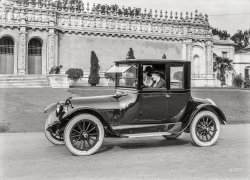
- Take Rheumo: 1890s
- 1890s New Zealand. "Grocery shop interior, with staff, location unidentified." Silver gelatin print, ... Posted by Dave - 10/16/2013 - 1:31pm -
![Take Rheumo: 1890s 1890s New Zealand. "Grocery shop interior, with staff, location unidentified." Silver gelatin print, photographer unknown. View full size.
Watch for falling crocksIn the event of an earthquake, the manner in which those groceries and breakable items have been stacked would spell disaster for the employees and their entire inventory of merchandise, never mind if someone thoughtlessly took a can from the bottom row of that tower of tins. Oy vey!
Oh; The Humanity!>>[That's Betty. Betty Crockery. - Dave]
I like the little kittens and puppies in cute little outfits. I can take the WWII cuties playing strip poker. I don't mind the occasional snarky comment from the distinguished moderators.
But the puns! There should be a warning of some sort before Shorpy's gentle readers are confronted with a facer like the above.
--Jim
ChamberpotsThe bowl and pitcher sets appear to have a third component, which I assume to be a matching nightsoil receptacle. I recall seeing only two-piece sets here in the U.S. A difference in style, or maybe the pots were not so desirable as antiques.
Who's that on the right?I think it's a WOMAN! Isn't she supposed to be hiding behind the crockery? And she's smiling! A nice change from those dour menfolk, I say.
[That's Betty. Betty Crockery. - Dave]
What shall I have?A quarter of laudanum, please. Oh, and some arsenic.
Not Much DifferentSave for the crockery, this might be any of a number of US neighborhood grocery stores before supermarkets drove them to extinction. The chairs are for madam to take her ease whilst the attendant fetches each item on her list, one can or packet at a time. Not immediately evident but certainly present are the extension tongs used to grab merchandise on high shelves. Produce and meats would, of course, be sold in other establishments. All that appears to be lacking is the sawdust spread on the floor to absorb spills -- and, of course, to provide bored and impatient five-year-olds the opportunity to practice the old soft shoe.
(The Gallery, New Zealand, Stores & Markets)](https://www.shorpy.com/files/images/SHORPY_FL16810792.thumbnail.jpg)
- Magnolia Mills: 1911
- March 1911. Magnolia, Mississippi. "Interior of Magnolia Cotton Mills spinning room. See the little ones scattered ... Posted by Dave - 06/14/2012 - 11:48am -
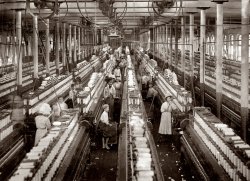
- All Electric Farm: 1936
- Washington, D.C., 1936. "Dept. of Interior exhibit -- kitchen at all electric farm." An early manifestation of ... Posted by Dave - 10/12/2016 - 12:26pm -
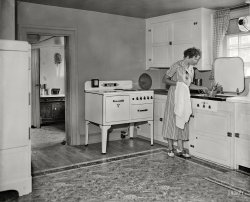
- Mightiest Electric: 1924
- ... will be erected to enable visitors to go through the interior and a staff of well informed representatives of the C. M. & St. P. ... Posted by Dave - 08/05/2014 - 3:07pm -
![Mightiest Electric: 1924 June 1924. Washington, D.C. "Largest and most powerful electric locomotive in the world being exhibited by the Chicago, Milwaukee & St. Paul Railway and the General Electric Co." Harris & Ewing Collection glass negative. View full size.
Monarch of the Rails
Washington Post, June 25, 1924.
Free Exhibit
Giant Electric Locomotive
Don’t fail to see this Monarch of the Rails—the pride of the “Milwaukee” road at New York and Florida Avenues, Washington, Wednesday June 25 and Thursday June 26.
These mighty electric locomotives, made by the General Electric Co., haul the Olympian and Columbian, famous Trans-Continental trains, silently, smoothly and speedily for 649 miles over the Rocky, Bitter Root and Cascade mountain ranges. Steps and platforms will be erected to enable visitors to go through the interior and a staff of well informed representatives of the C. M. & St. P. Ry. and General Electric Co will be in attendance to explain details. Admission Free. To Puget Sound—Electrified.
Proud to be "Bipolar"The five Milwaukee Road Class EP2 bipolar electric locomotives ran from 1919 to 1961, with a major rebuild in 1953. One has survived and is on display in St Louis. Amazing beasts.
Bipolar locomotivesThese locomotives used an unusual transmission system, which is to say, none whatsoever. The rotor and the wheels were mounted on the same axle, so that the whole thing moved up and down together. The arrangement was very quiet and avoided wear on driving gears or rods; the drawback was that there could only be two stator poles, so each motor was relatively low powered compared to what was achieved with more conventional motors. Every axle you see is driven except for the ones on either end directly behind the pilots. They were articulated seven ways from Sunday, with four trucks supporting three body sections.
One survives, in St. Louis.
Steamless in SeattleYes, the "Milwaukee Road" ran electrics to the Pacific Northwest from the early 1920s up to the early 1970s.
"...When these sections were placed in full electrical operation (Harlowton [MT] to Avery [ID] in 1917 and Othello [WA] to Tacoma [WA] in 1920) they represented the first long-distance electrification in North America and were the longest electrified lines in the world. "
Unfortunately, they never completed the gap between the two electrified routes (Avery to Othello). The electric locomotives were phased out and supporting infrastructure removed--just before the 1973-74 oil crisis (!)
See this article.
1953 RebuildDuring the rebuild of 1953 the Milwaukee bought 12 EF-4 and EP-4 replacements from GE. The 12 were part of an original order of 20 ordered by Stalin and bound for the Soviet Union but with the Cold War increasing the sale was blocked. The Milwaukee offered to buy all 20 from GE but it's BOT refused to go along but ultimately the Korean War and a coal strike led the BOT to approve the purchase. The irony was that Milwaukee first offered $1M for all 20 locomotives and spare parts but when finally allowed to buy the units only 12 still remained but the price remained the same.
(Technology, The Gallery, D.C., Harris + Ewing, Railroads)](https://www.shorpy.com/files/images/SHORPY-32400a.thumbnail.jpg)
- Reading Circle: 1942
- ... 1924-1990's, in the south-central part of town.
Many interior schoolroom shots, like this one, can look very much like Milldale ... Posted by Dave - 04/15/2015 - 4:41pm -
